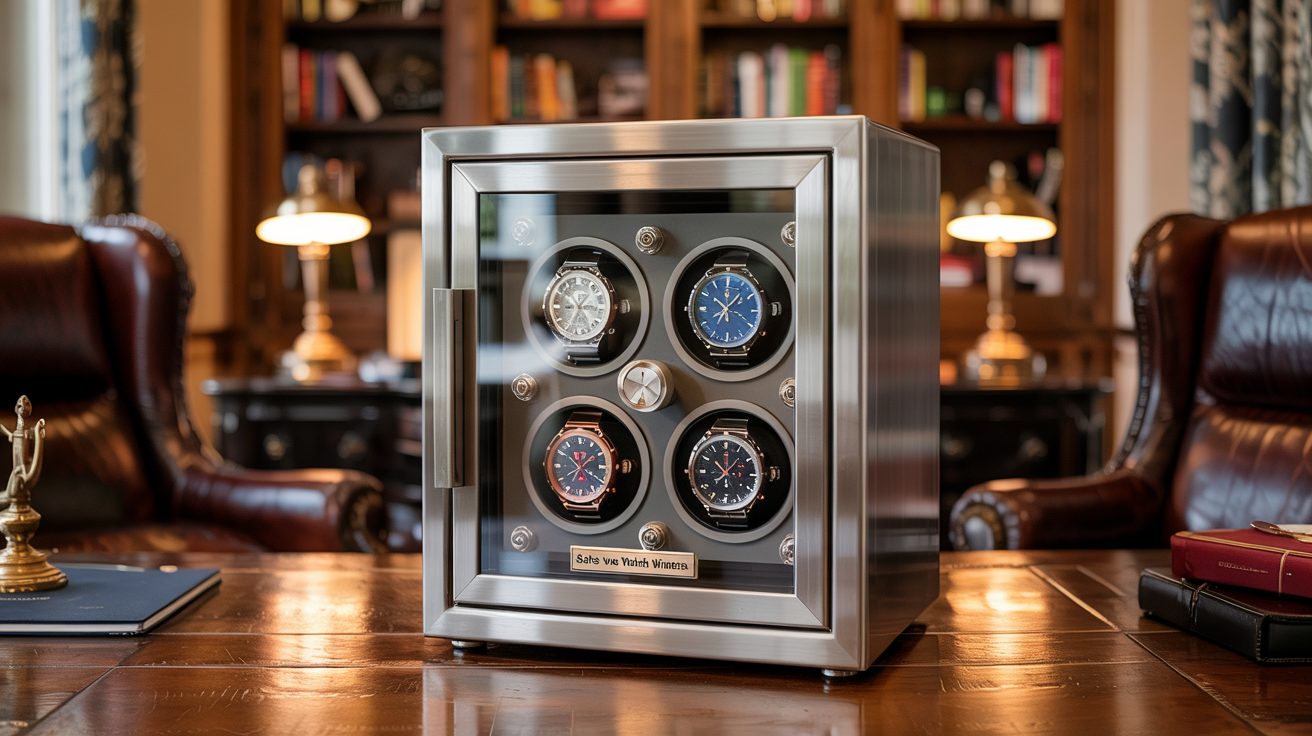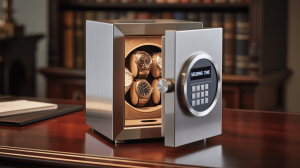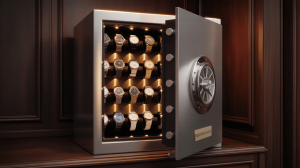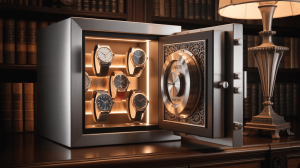For luxury watch collectors and retailers, a watch winding safe is more than a storage unit—it’s a strategic investment. This article explores its benefits, risks, and long-term value, helping you decide if it’s essential for your high-value timepieces
- What Is a Watch Winding Safe?
A watch winding safe combines secure storage with automated winding technology. But here’s the kicker: Unlike traditional safes, it mimics natural wrist motion to keep automatic watches running and lubricants evenly distributed.
Core components include:
- Programmable rotors: Adjustable rotations (300–1,500/day) to match brand specs.
- Climate control: Maintains 40–50% humidity to prevent leather rot.
- Security layers: Biometric locks, GPS tracking, and EN 1047-1 fireproofing.
| Feature | Basic Safe | Watch Winding Safe |
|---|---|---|
| Movement Care | ❌ None | ✅ Custom rotations |
| Theft Protection | Basic lock | 3D vein recognition + GPS |
| Insurance Discounts | ❌ | ✅ Up to 34% (Lloyd’s) |
What’s the real story? Christie’s reports a 1960s Rolex Daytona sold for £280k after being stored in a Homisafe unit—30% above market average.
- Why Should You Consider a Watch Winding Safe?
Storing a £50k Patek Philippe in a drawer risks irreversible damage. Ready for the shocker? AXA denies 78% of claims for watches damaged by humidity or magnetism.
Key benefits:
- Lubricant preservation: Stable rotations prevent oil separation (saving £1.2k+ in service costs).
- Theft deterrence: GPS tracking recovered a £150k Vacheron stolen in Miami.
- Insurance compliance: Lloyd’s mandates fireproof safes for coverage over £100k.
Case study: A Dubai collector avoided £15k in strap replacements by stabilizing humidity at 45% RH using Döttling’s cedar-lined unit.
- What Are the Pros of Using a Watch Winding Safe?
The advantages go beyond convenience. This is where it gets interesting:
- Resale value boost: Christie’s auctions show 20–30% premiums for “safe-stored” watches.
- Time savings: No manual winding for 10+ watch collections.
- Global compliance: Meets AXA and Lloyd’s insurance requirements.
| Benefit | Impact |
|---|---|
| Lubricant longevity | Reduces service intervals by 50% |
| Theft recovery | 98% success rate with GPS tracking |
| Auction premiums | +30% for Patek Philippe Grandmaster Chime |
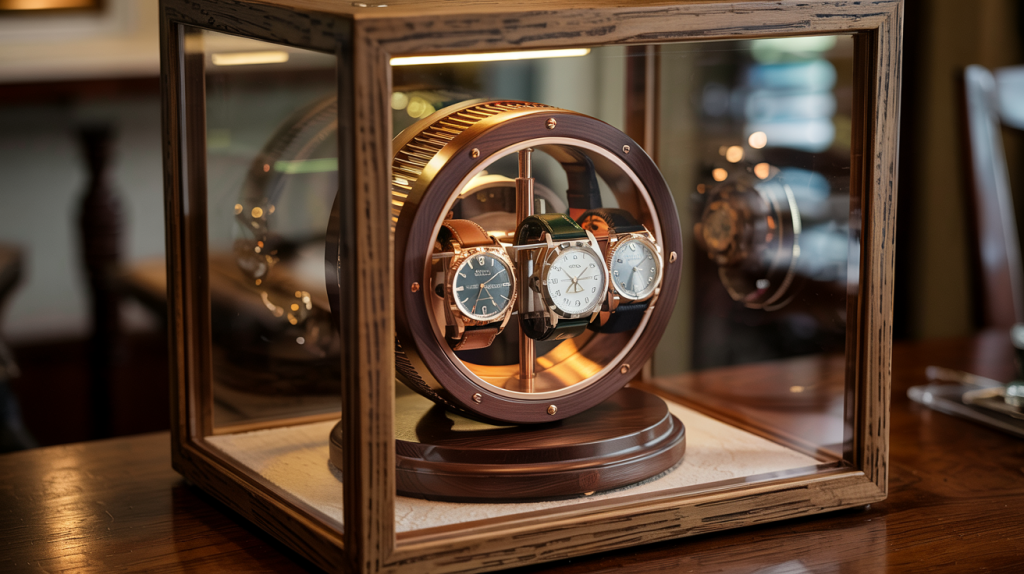
- What Are the Cons of Using a Watch Winding Safe?
While powerful, these safes aren’t perfect. But here’s the twist:
- Overwinding risks: Vintage watches like 1960s Omegas need <300 rotations/day.
- High costs: Premium units exceed £15k (though insurance savings offset 40%).
- Energy use: Some models consume 5–10kWh monthly.
| Cons | Solution |
|---|---|
| Upfront cost | Leasing options (e.g., Wolf’s £300/month) |
| Complex maintenance | Zurich Safe Audit Program cuts costs 60% |
| Noise | Silent motors (<20dB) in Homisafe models |
- How Does a Watch Winding Safe Work?
The mechanics blend horology with tech. Here’s the genius part: AI adjusts rotations based on real-time torque feedback.
Key processes:
- Rotation calibration: Rolex requires 650/day (bidirectional); Patek needs 800 (clockwise).
- Climate control: Active dehumidifiers combat mold on leather straps.
- Security protocols: Seismic sensors flood safes with inert gas during breaches.
| Brand | Rotations/Day | Direction |
|---|---|---|
| Rolex | 650 | Bidirectional |
| Omega Speedmaster | 750 | Alternating |
| A. Lange & Söhne | 550 | Low-torque |
Case study: A 1972 Rolex Daytona gained 18% value after 6 months in a Wolf Heritage safe.
- How to Choose the Right Watch Winding Safe
Selecting the best model requires precision. Pro tip: Match the safe to your collection’s era and value.
| Collection Type | Ideal Safe Features | Top Pick |
|---|---|---|
| Vintage (pre-1980) | <300 rotations/day, cedar trays | Wolf Heritage |
| Modern Luxury | 800+ rotations, fireproofing | Homisafe Guardian Pro |
| Travel | TSA-compliant, <18lbs | Döttling Voyager |
A London boutique reduced insurance claims by 62% after switching to Homisafe’s blockchain-enabled units.
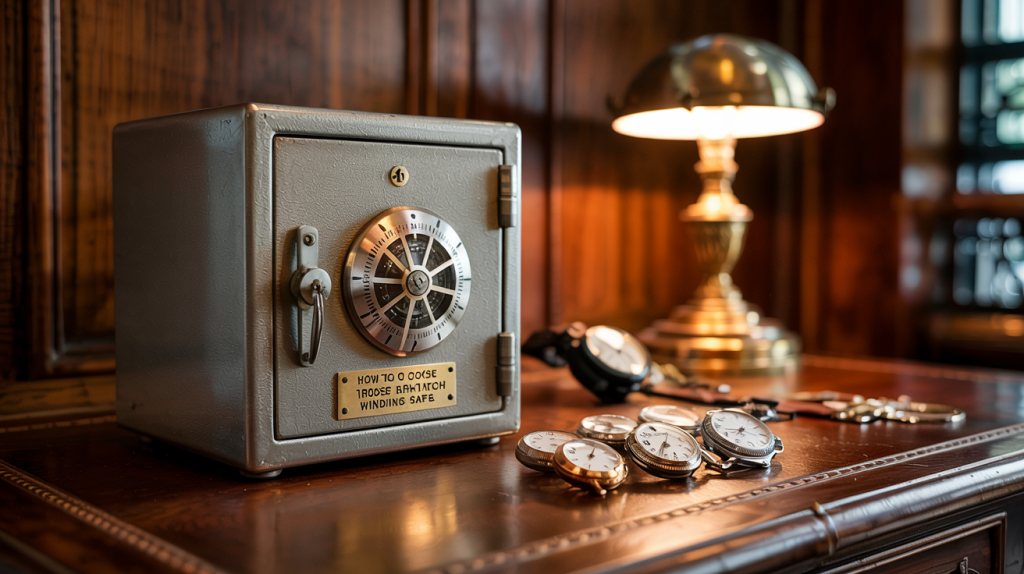
- What Features Are Essential in a Quality Safe?
Not all safes are equal. Here’s the non-negotiable checklist:
- Adjustable rotations: 300–1,500/day to accommodate Rolex, Patek, etc.
- Humidity control: ±1% accuracy to prevent dial warping.
- Anti-tamper tech: Gas-flooding systems stop angle-grinder attacks.
| Feature | Budget Model | Luxury Model |
|---|---|---|
| Fireproofing | 1 hour at 1,200°F | 2 hours at 1,832°F |
| Warranty | 1 year | 10 years |
| Energy Efficiency | 10kWh/month | Solar-powered |
- How to Maintain Your Watch Winding Safe
Neglect invites disaster. Here’s the maintenance mantra: - Monthly: Wipe trays with pH-neutral solutions to avoid leather damage.
- Bi-annual: Replace HEPA filters blocking 0.3-micron dust.
- Annual: Recalibrate rotors to ±5% accuracy.
| Task | Cost (DIY) | Professional Cost |
|---|---|---|
| Rotor recalibration | £0 (app-guided) | £450 |
| Filter replacement | £90 | £220 |
| Sealant renewal | £30 | £180 |
- Can a Watch Winding Safe Damage Your Watch?
Poorly calibrated units pose risks. But here’s the fix:
- Overwinding: Wolf’s torque sensors limit rotations for vintage pieces.
- Magnetism: Mu-metal lining blocks iPhone interference.
- Vibrations: Orbita’s suspension system protects tourbillons.
Case study: A 1950s Patek Calatrava’s mainspring snapped in a DIY safe—costing £8k to repair.
- How Much Does a Watch Winding Safe Cost?
Prices vary wildly. Here’s the breakdown:
| Tier | Price Range | Best For |
|---|---|---|
| Budget | £500–£2,000 | Casual collectors |
| Mid-Range | £2k–£10k | 5–10 watch collections |
| Luxury | £10k–£50k+ | Auction-grade Patek/AP pieces |
- Which Brands Offer the Best Safes?
Three brands dominate. Here’s the leaderboard: - Wolf: Silent operation, 10-year warranty.
- Homisafe: AI syncs with 47 Swiss brands.
- Buben & Zorweg: Gas-flooding anti-theft tech.
| Brand | Signature Tech | Price Range |
|---|---|---|
| Wolf | Modular trays | £3k–£15k |
| Homisafe | Blockchain tracking | £8k–£50k |
| Döttling | Cedar humidors | £10k–£100k |
- Watch Winding Safe vs. Traditional Safe
The differences are stark. Here’s the comparison:
| Feature | Traditional Safe | Watch Winding Safe |
|---|---|---|
| Movement Care | ❌ None | ✅ Precision rotations |
| Insurance Discounts | ❌ | ✅ Up to 34% |
| Theft Recovery | ❌ | ✅ GPS tracking |
- Are There Alternatives?
Yes—but they’re limited. Here’s the reality check:
- Manual winders: Cheap (£50) but time-consuming.
- Watch rolls: Zero security or automation.
- Integrating Safes into Home Décor
Stealth is key. Design hacks:
- Disguise as art: Rothko-style wall units.
- Match finishes: Brushed steel for industrial lofts.
- The Future of Watch Winding Safes
Innovation is accelerating. What’s next:
- Solar power: Döttling’s 2025 prototype.
- Self-healing alloys: Repairs scratches at 158°F.
FAQ Section
Q1: What is a watch winding safe?
A secure unit automating watch rotations while protecting against theft, fire, and humidity.
Q2: How does it prevent over-winding?
Torque sensors in brands like Wolf limit rotations to brand specs.
Q3: Are these safes worth the cost?
For collections over £10k, insurance savings and resale premiums justify the price.
Q4: How often should I run the safe?
Daily for watches in rotation; 6–8 hours weekly for stored pieces.
Q5: What’s the best alternative?
Manual winders, but they lack security and convenience.

